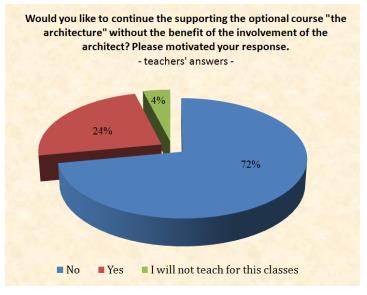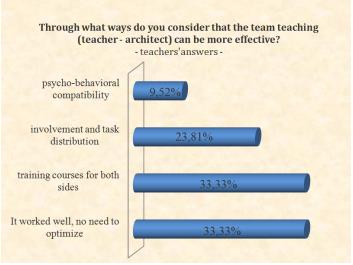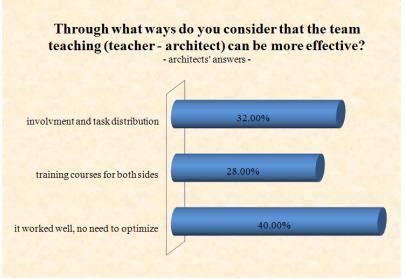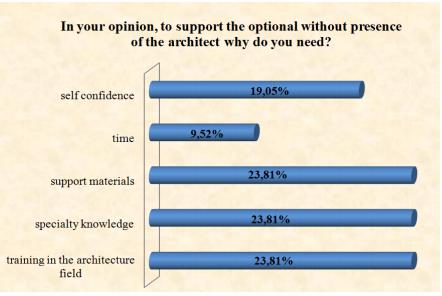Abstract
This research is part of a broader research on education through architecture that was held at the Institute of Education Sciences in 2015. The project ” Playing with architecture” was implemented in grades III and IV in more than 100 schools, by the Association ”De-a Arhitectura”. In 2014 the schedule was approved by the Ministry of Education in Romania. The research instruments consisted of questionnaires applied to a group of 36 teachers and 43 volunteer architects. The research aims to analyze, in a qualitative perspective, the perceptions of teachers and volunteers architects on the utility of the class curriculum ”For the architecture. Education for architecture and built environment”. The interpretation of data obtained by questioning the teachers and architects volunteers for this optional discipline present in the National Base of school curriculum analyzes among others the autonomy of teaching activities within the architecture through the following directions: the desire for autonomy and the need for training. It's the kind of discipline that may be considered part of the transdisciplinary curriculum as it brings in the center of the individual with all that entails him: interdisciplinary knowledge, consciousness, creativity, imagination, skills, theoretical, practical, craft, manufacturing, sensitivity and cultural expression, empathy, team spirit. Such an approach leads to increased self-awareness, to self-valorization, the integration of the individual in nature and socio-cultural microclimate. The skills acquired through such an optional help children in life skills needed for future adult develops spatial thinking.
Keywords: Curriculum; inter- and transdisciplinarityeducation through architecturelife skillsbuilt environmentco-teaching
1.Introduction
Architectural elements taught in school connect the related areas such as STEM (Science,
Technology, Engineering, Mathematics), spatial planning, interior or exterior design, green space. At the
same time, design activities involves and promotes creativity, inquiry, encourages students to work both
individually and in teams. Education through architecture is the vehicle for stimulating learning and
discovery beyond the basic disciplines, cultivate students' observation skills, critical thinking, problem
solving through creativity and imagination, interdisciplinary learning experiences. The knowledge base is
diverse, representing the very order of the universe. Education through architecture cultivate visual
literacy and understanding of the design process; inspires students to be active in civic point of view, to
think creatively, solve problems and work in various team/ to lead a team; build partnerships with other
teams, collaborate with various professionals; introduce students to new areas such as architecture,
landscape, design, historic preservation, urban planning, engineering, construction. In school the focus is
to evaluation and storage, for exploration is generally less time. The architecture optional teach the
children to apply their knowledge (that seem most often abstract or without utility) in concrete situations
in real life. Children learn about architecture projects through play and imagination through model
building using different materials. The main topics of investigation are architectural elements such as the
relationship between the built environment and nature, space, light and shade, colors, shapes, materials,
structures, scale and proportion, opening and closing, timing and movement. Tradition and cultural history
are also part of the curriculum. So, the class runs in team teacher - volunteer architect, who helps
themselves and complement each other. The paper is focused on cooperative team teacher-architect and
on the need for autonomy of teachers in the ”Playing with architecture” project, (the architects are
volunteers).
1.1.Theoretical Background about Art Education
The education system is a means of preparing children for adult life. Through education is
understood not only acquiring knowledge but also skills training, values, development of imagination and
creativity for useful and beautiful. Education must ensure inter alia the opening up towards knowledge
and recognition, appreciation and cultivation of artistic values. Children's progress is monitored across
whole curriculum, but assessment in the arts is a challenge because it requires personal talent. The
creative application of curriculum involves the harnessing by teacher-student team of the knowledge
acquired in various ways, non-formal or informal education, relating to real life skills (Bostan, 2015).
Bamford (2009) states that the main purpose of assessment in the arts should focus clarify and make more
concrete the goals of learners within a program. Assessment can be used both formative (during learning)
and summative (end of a learning sequence) to provide a proof of student learning. The assessment
methods must capture the different kinds of learning as experimented by child and what it produces
effectively. Research in the field of arts assessment that have done (Taggart et al., 2004) found that the
valuation methods used by teachers involve requesting students to interpret an artwork or produce a work
on a specific subject and consider the creation process of the students too.
The Guide Map for Arts Education of UNESCO – asserts that arts education helps in: approval of
the human right to education and cultural participation; developing individual capacities; improving the
quality of education and promoting the expression of cultural diversity (UNESCO, 2006).
In 1995 the Council of Europe launched a major project that focuses on Culture, Creativity and
Youth, which examined arts education in schools of Member States and the involvement of professional
artists; this one resulted in a research of the arts education in Europe (National Advisory Committee on
Creative and Cultural Education, 1999) and an international colloquially.
In 2005, the Council of Europe launched the Framework Convention on the value of cultural
heritage for society. This identified the need for European countries to preserve and promote cultural
identity and to encourage intercultural dialogue.
The research of Taggart (Taggart et al. 2004) found that cultural education promoted in EU
Member States (on that date) include the development of artistic skills, knowledge and understanding, the
involvement in a variety of art forms, the increased cultural understanding, artistic sharing experiences,
becoming both arts consumers and taxpayers. From the artistic education it expected outcomes such as
self-confidence, individual manifestation, teamwork, interculturality, participation in cultural life. The
educational systems use in teaching of artistic disciplines to small classes, teachers with general education
(Bamford, 2006). Taggart (Taggart et al. 2004) notes that teachers lack confidence (which emerges from
the present research – Q3, 19.05 %). It should be considered also the initial training in the arts, as well as
continuing professional development. There are few concerns related to monitoring the quality of teaching
in the arts subjects, but we can mention several authors like Bamford, Robinson, Sharp, Le Metais,
Taggart (Bamford 2006; National Advisory Committee on Creative and Cultural Education 1999; Sharp
and Le Metais 2000; Taggart et al. 2004).
2.Research Design
This research is part of a broader research on education through architecture that held at the
Institute of Education Sciences in 2015. (Mihăilescu et al., 2015) The project ”Playing with architecture”
was implemented in grades III and IV in more than 100 schools, by the Association ”De-a Arhitectura”.
In 2014 the schedule was approved by the Ministry of Education in Romania. (Ordinul Arhitecţilor din
România, 2013) The research instruments consisted of questionnaires applied to a group of 36 teachers
and 43 volunteer architects.
2.1.Research Questions
The desire of autonomy of teachers has been explored by questions:
=for teachers:
=o =Q1: Would you like to continue the supporting the optional course "Playing with
architecture" without the benefit of the involvement of the architect? Please motivate
your response.
o Q2: What ways do you consider to be more effective in the team teaching (teacher - architect)?
o Q3: In your opinion, to support the optional without presence of the architect what do
you need?
=for architects:
=o =Q2a: What ways do you consider to be more effective in the team teaching (teacher -
architect)?
3.Results and Discussions
72% of teachers answered that they do not wish to teach the course without the help of the
architect because they believe that they lack the knowledge. Moreover, there is no methodology course
for teaching this optional. At the same time, each has well-established role and it is working well in
teams.
A quarter of respondents teachers (as seen in the figure
teach the optional subject, but recognize that the architect has expertise which the teacher doesn't have
and that it is useful the support of an architect. A small part - 4% of respondents answered that they will
not have classes III / IV in the next years.

For the question Q2, teachers had the answers in somewhat balanced proportions in the sense that
one third believed that worked well in the formula chosen, one third agreed that streamlining Team
teaching would improve if both actors - teachers and architects would participate in training courses. The
remaining one third was more nuanced, meaning that 23.81% supported the involvement and task
distribution, and the remaining of 9.52% that the team must be psycho-behavioral compatible. (fig. 2)

The answers of volunteer architects who were asked what are the ways to optimize teaching of
discipline "The architecture" were somewhat balanced, but most of them - 40% said that team teaching in
their case worked well; as observations they have noted it would be beneficial the elimination of all
systems to encourage bureaucracy: headings, points and other documents which "kills education".
Problems such as those linked to offering schools the projectors required for teaching or the accessibility
from schools to places for expeditions. There were also opinions on the fact that some children and their
parents have no respect for the teacher, no matter who he is. 32% of the architects responded that the
involvement of and task distribution are essential. The smooth conduct of the course first of all implies an
optimum communication between architect and teacher. Teachers should be motivated to teach this
course, to see him as an opportunity to teach children useful things in life, be willing to learn same time
with them and not to cede on first lesson with difficulties. Even if the architect feels comfortable to teach
this course, the roles should not be reversed. Lessons must be prepared together with the teacher before
the lesson and the role of each must be established in the conduct of the lesson. Multiple simulations to
the training workshop are also beneficial. 28% of respondents have come up with various solutions such
as: the architect to come less often; teachers to take on the course curriculum; participation of both
members of team to training. Practicing this collaboration from the training session in classroom has as
main objective reciprocal knowledge and establishing trust relationships between two people who make a
team. (fig. 3)

The training need for becoming autonomous has been explored by question Q3 addressed to
teachers. The figure below (fig.4) shows that approximately 19% (almost one-fifth of the participant
teachers) do not trust to their capacity to teach this optional course. The need for training consists of:
training in the field (23.81%); specialized knowledge (23.81%), material support (23.81%) and time
(9.52%).

4.Conclusions
The research aims analyse, in a qualitative perspective, the perceptions of teachers and volunteers
architects on the utility of the class curriculum ”Playing with architecture. Education for architecture and
built environment”.
The opinions of participants in the study concerning the constraints which they identified during
the team-teaching experience of the curriculum on school decision “Playing with architecture” refer to the
size of the resources, relationships, and professional roles. Approximately one quarter of teachers and a
third of the architects that participated in research, considered that there are no constraints on teaching/
team collaboration.
Regarding the resources, both categories opined that available time is limited. Some relevant
aspects of time management in relation to specific needs of formal education context refers to lack of
time or availability to prepare lessons together, the disparities between the work program of the architects
and the teachers regulated within the school schedule. The constraints linked to the lack of financial
resources are reported more often by architects, while the concern for material resources is common and
refers to technical support for smooth conduct of hours and to necessary video means.
In the opinion of architects participating in the study, the efficiency of collaborative relationships
is affected when there is a lack of interest from the teacher linked to this optional curriculum at the school
decision. It is also seen as an obstacle, the teacher's lack of interest or a low level of information related to
the architectural profession, which assumes an inflexible attitude or not recognizing the importance of
each other 's profession.
In the opinion of teachers, collaboration and assuming some roles within the team can be affected
by factors which reflect the availability of communication or personality attributes of architects (the
difference in temperaments, different personalities), respectively by the degree of empathy of these two.
In the view of several architects, quality of partnerships is affected in situations where the teacher leaves
all in the responsibility of the architect, taking a limited role and a lack of flexibility in certain situations.
A more careful analysis is required to see if the teacher reserve a passive position and is strictly related to
his role of monitoring classroom / or lives an uncomfortable professionally due to lack of expertise in a
new field and a desire to imply in new roles.
The implications of professional determinants reveal adjustment needs of the implementation of
the curriculum at the assimilative capacity of children. The teacher recalls obstacles that are explained
through lack of teaching experience of the architects, in building of students' learning path and the
adaptability to the level of the students. The needs are mentioned to apply more and diverse teaching
methods and interaction with children and to ensure compliance with school rules. The architects feel the
need to setup a team, a common professional language.
About a quarter of architects, ie a third of teachers appreciates the current working formula or not
formulates an opinion on the effectiveness of teaching in the team. Other views of respondents on ways to
streamline Team teaching are structured in the following areas:
=the willingness to work together and defining some compatibility criteria of the team;
=school resources - material and financial resources need is correlated with support for teaching
into the team through learning activities that have a practical component, applicative, which
require substantial organization to a larger number of events in formal and non-formal learning
environment;
improving the working class resources - a manual dedicated to this optional course may be
divided into sections with activities for teachers and sections addressed architects. It would be a
useful a methodological guide for both teachers and architects that to explain and describe the
roles of participants in every moment of the lesson;
emphasis on practical dimension of the program and continuity over time - efficiency of approach
is correlated with organizing several educational and extracurricular results which will follow to
develop the competences contained into the syllabus;
collaboration for designing lessons - the close collaboration and mutual support teacher-architect
are considered the crucial attitudes for the success of Team teaching. Both groups participating in
research consider that is requires training and prepare together in advance of lessons.
Collaboration is necessary in choosing learning activities, a better design of teaching, establishing
the role of each team member in conducting lesson;
collaboration in running the lessons - the efficiency of teaching in team could be achieved by
applying a teaching formula in which each partner switch the moments of lesson alternatively,
architect-teacher, according to the topic;
ways of training - participants in the study consider necessary the training both in the field of
architecture (for teachers) and of didactics for architects;
communication strategies for professional development - professional training with the specificity
of methodical meetings practiced in the education system.
Interpretation of data obtained by questioning the teachers and architects volunteers for this
optional discipline present in the National Base of school curriculum analyses among others the
autonomy of teaching activities within the architecture through the following directions: the desire for
autonomy and the need for training. Teachers want to teach architecture, but may not dispense with the
help of architects.
It's the kind of discipline that may be considered part of the transdisciplinary curriculum as it
brings in the centre of the individual with all that entails him: interdisciplinary knowledge, consciousness,
creativity, imagination, skills, theoretical, practical, craft, manufacturing, sensitivity and cultural
expression, empathy, team spirit. Such an approach leads to increased self-awareness, to self-valorisation,
the integration of the individual in nature and socio-cultural microclimate. The skills acquired through
such an optional help children in life skills needed for future adult develops spatial thinking.
The involvement of professional artists in arts education, in this case of architects, improve the
quality of teaching and learning of the arts, encourage creativity, the interdisciplinary teaching, education
for life, improving skills and self-confidence of teacher, as well as providing access to a broader range
cultural resource.
References
- Bamford, Anne, (2009). Arts and Cultural Education in Iceland, Ministry of Education, Science and
- Culture, Reykjavík, Retrieved from: https://www.menntamalaraduneyti.is/media/MRN-
- pdf_reports/ann_bamford.pdf
- Bostan, Carmen-Gabriela, (2015). Inter-and Transdisciplinary Issues Present in the School Curriculumm,
- Procedia-Social and Behavioral Sciences, Volume 180, p. 489-496
- Legea Educaţiei Naţionale nr.1/ 2011, Retrieved from: http://lege5.ro/Gratuit/geztsobvgi/legea-educatiei-
- nationale-nr-1-2011, accesed 2016
- Mihăilescu, Angelica (coord.), Bostan, Carmen-Gabriela, Iacob M., Voinea, L., Bercu, Nicoleta, (2015), Contribuții la un model de evaluare a competenţelor dezvoltate de educaţia prin arhitectură, Raport de Cercetare, Institute of Educational Sciences, Bucharest National Advisory Committee on Creative and Cultural Education, (1999), All Our Futures: Creativity, Culture and Education, Retrieved from: http://sirkenrobinson.com/pdf/allourfutures.pdf Ordinul Arhitecţilor din România, Association ”De-a Arhitectura”, (2013). De-a arhitectura în orașul meu, Educație de arhitectură și mediu construit pentru ciclul primar, Prezentare support de curs, from: http://de-a-arhitectura.ro/wp/wp-content/uploads/2013/03/de-a_arhitectura.pdf, Retrieved accesed 2016 Sharp, Caroline, Le Métais, Joanna, (2000). The Arts, Creativity and Cultural Education: An International Perspective, Qualifications and Curriculum Authority, London, Retrieved from: https://www.nfer.ac.uk/research/centre-for-information-andreviews/inca/TS%20Arts,%20creativity%20and%20cultural%20education_An%20International%2 0Perspective%202000.pdf Taggart, G., Whitby, K. & Sharp, C., (2004). National Foundation for Educational Research International Review of Curriculum and Assessment Frameworks Curriculum and Progression in the Arts: an International, Study Final Report, National Foundation for Educational Research, Retrieved from: https://www.nfer.ac.uk/publications/CPQ01/CPQ01.pdf UNESCO, (2006). Road Map for Arts Education The World Conference on Arts Education: Building Creative Capacities for the 21st Century, Lisbon, 6-9 March 2006, Retrieved from: http://www.unesco.org/new/fileadmin/MULTIMEDIA/HQ/CLT/CLT/pdf/Arts_Edu_RoadMap_en.
Copyright information

This work is licensed under a Creative Commons Attribution-NonCommercial-NoDerivatives 4.0 International License.
About this article
Publication Date
25 May 2017
Article Doi
eBook ISBN
978-1-80296-022-8
Publisher
Future Academy
Volume
23
Print ISBN (optional)
-
Edition Number
1st Edition
Pages
1-2032
Subjects
Educational strategies, educational policy, organization of education, management of education, teacher, teacher training
Cite this article as:
Bostan, C. –. G. (2017). The Need For Autonomy Of Teachers In ”Playing With Architecture” Project. In E. Soare, & C. Langa (Eds.), Education Facing Contemporary World Issues, vol 23. European Proceedings of Social and Behavioural Sciences (pp. 476-483). Future Academy. https://doi.org/10.15405/epsbs.2017.05.02.58

